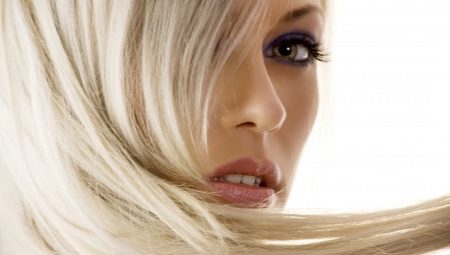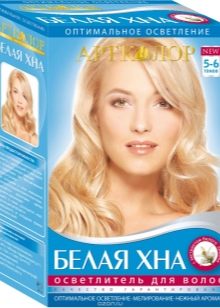All about white henna

Many dyes for lightening hair can be found on store shelves. One of the popular remedies is white henna. This paint, like any other coloring matter, has its own advantages and disadvantages. This article will discuss the features of the drug, as well as the intricacies of its use.

What it is?
Henna for hair is known to everyone as a dye made from natural ingredients of plant origin. However, there is not only natural henna, the modern cosmetic industry also produces synthetic products with the same name.
Contrary to the name, white henna is not a natural remedy... Its composition is dominated by chemicals, and the paint got its name due to the presence of one natural component - colorless henna. It also includes the following components:
- ammonium persulphate;
- hydrogen peroxide;
- lemon acid;
- magnesium oxide;
- magnesium carbonate;
- water;
- carboxylated methylcellulose.
White henna is used to lighten curls.



With a single use, the shade of the hair becomes 4-6 times lighter.
Despite the fact that the paint contains such a natural component as colorless henna, the agent is synthetic and does not have hair strengthening properties.
Advantages and disadvantages
Compared to other hair lightening products, white henna has its pros and cons. The benefits include the following factors.
- Has a good brightening effect... Unlike many clarifiers, it allows you to get a visible result from the first application.
- Ease of use. It is not necessary to visit a professional hairdresser to apply paint. The procedure can be carried out at home on your own.
- Low cost.
- Uniform brightening hair along the entire length.


Also, white henna has a number of significant disadvantages.
- The main disadvantage of the tool is negative effect on hair structure. Synthetic components of the dye make hair dry and brittle.
- For lightening dark curls multiple staining requiredwhich, in turn, is bad for hair health.
- Means can not be used for dyeing gray curls, as well as after a perm.

Preparation for painting
Before lightening with white henna curls must be prepared in advance for the procedure. As a result of staining, the agent does not remain on the scalp, but it can negatively affect its condition. Therefore, it is not recommended to wash your head two days before painting, which will protect the skin and hair from chemical burns.
Henna should not be applied after hair perm and dyeing procedures.
After the last painting of curls, at least 30 days should pass. Also do not use dye to lighten damaged and weakened hair.
On white henna there is an allergic reactiontherefore a test must be carried out before staining. To do this, a small amount of the composition is applied to the skin in the bend of the elbow and left for 20 minutes, after which it is washed off with water. If redness, rash or itching does not appear on the skin, then the mixture can be used to dye the hair.
It is important to properly prepare the coloring composition for application to curls. To do this, you need to carefully study the instructions for the paint... Failure to follow the rules for using white henna can lead to chemical burns or unexpected staining results.



Required materials and tools
Before you start staining with white henna at home, you need to prepare all the necessary accessories. To protect the skin of the hands from the dye composition, use gloves... Most often they come with paint.
To protect clothing from staining, you will need special cape. To breed white henna, you need a deep container, and a wooden or plastic stick to stir it. To protect areas of skin near hair, it is recommended to apply petroleum jelly or baby cream.
To apply the coloring composition to the strands, you can use a special brush or toothbrush. After applying henna to your head, you need to put on a special cap or a regular bag and tie a towel around your head. After washing off the paint, it is recommended to wash your hair with shampoo and apply to them conditioner balm.



Dyeing technology
Before dyeing, it is important to properly prepare the dye composition. The proportions of white henna and hot water will be indicated in the instructions for the paint. After the mixture is ready, you can start applying it.
It is necessary to distribute white henna from the roots, gradually descending to the tips... In order for the roots to paint over better, after applying the product with a brush, you need to massage the scalp with your hands. Henna dries out pretty quickly on the hair, so you need to put it on your head a special hat or plastic bag immediately after the staining procedure. For a better effect and the effect of the substance on the hair structure, the head can be tied warm handkerchief or towel.
The exposure time of henna on the hair depends on several factors and can be from 10 to 40 minutes. First of all, you need to familiarize yourself with the recommendations that the paint manufacturer indicated in the instructions. The longer you keep the dye composition on your hair, the more it will lighten.



The recommended maximum staining time is 30 minutes. If you keep henna longer, then the risk of ruining the curls increases, as well as getting chemical scalp burn... The paint is thoroughly washed off under running water at room temperature. To completely remove the composition from the hair, you must use shampoo.
At the end of the procedure, a conditioner balm must be applied to the strands. Usually the product comes with white henna, but you can use another balm as well.
It is recommended to soak the composition on the hair for 15 minutes, then rinse with water. If, as a result of staining, it was not possible to achieve the desired shade the first time, the procedure can be repeated no earlier than one week later. On re-clarification it is not recommended to change the shade of the strands to the most contrasting tones... It is best to gradually achieve the desired result, which will allow you to do minimal damage to your hair.

Care
The procedure for lightening hair negatively affects their condition, therefore, after dyeing, it is required special care for curls. It must also be remembered that, upon contact with certain substances, the clarified strands may change their color.
After staining do not use shampoos and other hair care products that contain sulfates... It is best to use professional lines for the care of bleached curls. Hair needs intensive care in the first three weeks after dyeing.



In addition to professional remedies to restore damaged hair, you can use folk recipes... Oils such as olive and castor nourish dry brittle hair. They can be applied to curls in their natural form, or used to prepare restorative masks.
Reviews
According to reviews of girls who used white henna for lightening, the result from the procedure does not always meet expectations. If the product was applied to dark curls, then after the first staining, it will not work to get snow-white strands... In this case, the hair will turn red or yellowish.
Also, women note that after using the paint, the condition of the curls worsens. Hair becomes brittle, dry and naughty. In this case, the condition of the hair before the lightening procedure is of no small importance. Henna will do the most harm to initially unhealthy and damaged hair.

The benefits of using white henna for lightening hair can be found in the video below.








